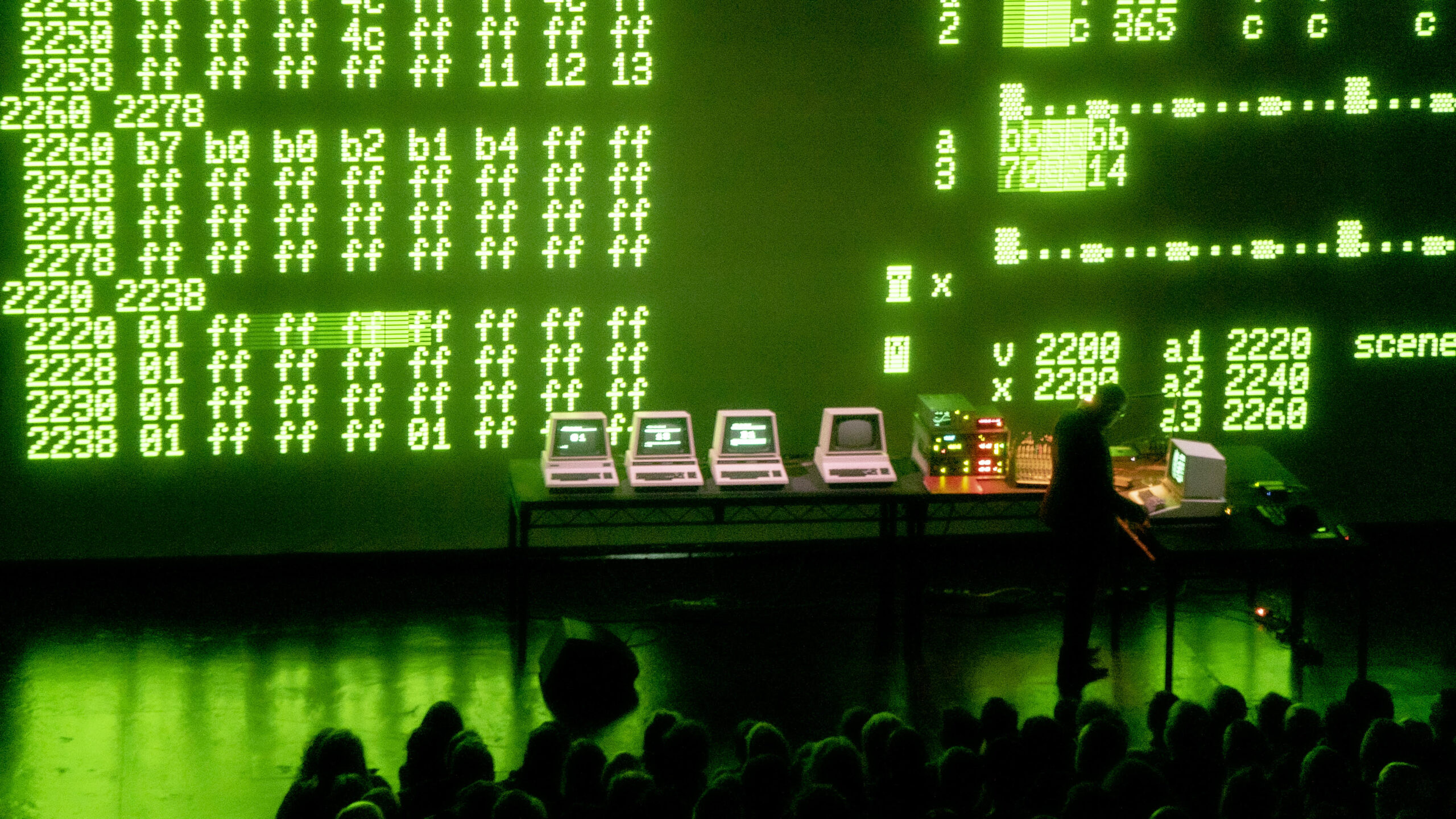Words: Fleur Kas (she/her)
When most people hear ‘Berlin,’ they call to mind the Brandenburg Gate or Berghain. However, it is time to associate it with Robert Henke. Henke is a digital artist who experiments with coding and hardware to create compositions and performances, paying homage to club culture and contemporary music. As part of Sonica, a Glaswegian festival celebrating national and international audio-visual art, Tramway had the pleasure to host him on September 29th for an iconic performance titled CBM 8032 AV. ‘The first three computers produce the sound, the fourth the visuals and the one on the far-right controls everything else’ Henke explains in his brief introductory lecture, clarifying the enigmatic set-up of Commodore computers behind him. Ironically, he adds that it is all 80s technology besides the modern projector on which we have the pleasure of seeing his talent unfolding. Performing in a tan suit and tapping his foot along to eccentric rhythms, Henke turns to his circuit of 80s computers to present a stimulating 70 minutes of sound and vision.
Although his visuals are anything but minimalistic, Henke reduces his colour palette to a simple combination of black and green. He justifies this choice as a ‘relief’ in an age where we are constantly bombarded with pixels of the whole roygbiv. His visuals progress from rows of seemingly randomized digits to waves of neon ripples, to ultimately a complex circle of angel numbers that is blotted out by black before the curtain call. Whilst Henke hovers over his computers, we can see their screens buzzing with activity. What particularly intrigued me were the sound computers, on which we could see notes racing up and down, although it somewhat reminded me of the frustrations of tuning my guitar. In all honesty, some parts of his performance made me feel the need to close my eyes for just a brief moment, yet the allure of Henke’s art makes a subtle eyesore worth it. As for his sounds, they don’t necessarily fuse together elegantly, but that is not his artistic intention in the first place. Reminiscent of Aphex Twin, Thom Yorke and Massive Attack, Henke’s music is rich in distortion, allowing you to lose your train of thought as you are hypnotized by his green wave.
However, like all great art, Henke’s performance burns (or rather, pixilates) significant questions in your mind. For instance, what does it mean to create contemporary art out of outdated technology? As Henke noted in his lecture, computers were only available in elite institutions in the 80s, thus being inaccessible to everyday people like himself. Additionally, he adds how he built his own software back in this period, emphasising his innovative skills. To use this tool as a creative medium forty years later could therefore be interpreted as an, albeit belated, act of resistance against authority. Then again, this form of rebellion is relevant to our present relationship with technology too. Algorithms and social media giants are gaining incomprehensible power in our digitalized world, yet being able to manipulate software like Henke does demonstrates the potential of using our creativity and knowledge to challenge these circumstances. We may never truly understand all that those in power, or our devices, are capable of, but we can transform these uncertainties into art.
That being said, Henke’s understanding of the past and present power structures that underpin technology translates into an unforgettable, artistic performance. It is far from being aesthetically pleasing; rather, its cacophony is metaphorical for his underlying objective of confronting the spectator with these pressing issues. As mentioned previously, Henke’s performance contains many flickering lights as well as rapid, repetitive sounds which Sonica adds as a content warning to the event. Fortunately, the festival also hosted events for people who may be excluded from this performance as a result, such as performances by the Glasgow African Balafon Orchestra and Glaswegian-Zimbabwean rapper Eyve. Henke also gave a longer lecture at GSA about his creative process, which was free to the public, demonstrating Sonica’s successes in making the festival as inclusive as possible. On behalf of Glasgow’s student community, we warmly invite you, Henke, to play a show on Subcity Radio and we’d love another performance from you at Sonica next year. Bis dann!
Image credits: Wei Zhou
Sonica: https://sonic-a.co.uk
Henke’s biography (referenced in introduction): https://roberthenke.com/interviews/bio.html

